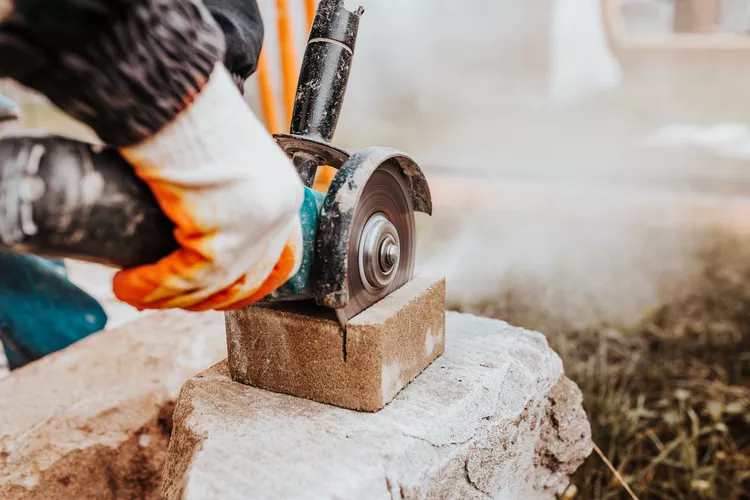How to Cut Pavers for All Your Outdoor Projects

Installing paver patios and walkways is one of the best ways to spruce up your home’s curb appeal. While labor intensive, paver installation is fairly DIY-friendly, meaning you can save serious money by doing the job yourself. What intimidates many homeowners from DIY paver installation is the act of cutting the pavers. If you’re unfamiliar with the process of cutting pavers, it can seem daunting.
However, cutting pavers is easier than it seems and can be done with a variety of tools. We’ve provided step-by-step instructions for cutting pavers with tools like circular saws, angle grinders, chisels, and table masonry saws.
Before You Begin
The different methods for cutting pavers allow you to tailor the project toward tools you already have and the method you feel most comfortable with. However, each one has its advantages and disadvantages that may make it better or worse for the project at hand.
Here are some of the advantages of each paver-cutting method:
- Chisel: The chisel method is easy for beginners and utilizes tools you likely already have. If not, these tools are relatively inexpensive. However, if you’re looking for precision cuts or have a lot of cuts to make, this isn’t the best method.
- Circular Saw: A circular saw fitted with a diamond blade will make quick work of cutting pavers cleanly. However, this tool can be hard to use for those who aren’t familiar with them.
- Angle Grinder: An angle grinder is great for making small, detailed cuts in pavers. However, using an angle grinder extensively is hard on your back and creates a lot of dust, as you can’t fit a water source to an angle grinder.
- Table Masonry Saw: A table masonry saw is a favorite among hardscape installers, as it’s ideal for cutting down on dust, making clean, precise cuts, and saving your back because it doesn’t require bending over during cutting. However, these saws are expensive, so we recommend homeowners rent instead of buy.
Safety Considerations
Power saws are dangerous and should be used with extreme caution. Always wear eye and ear protection and keep your hands and feet away from the blade. Cutting pavers and other masonry products produces silica dust. Use a dust collection system or a wet saw and wear a dust mask rated for silica dust.
What You’ll Need
Equipment / Tools
- Cold chisel
- Hammer
- Mallet
- Circular saw with a diamond blade
- Angle grinder with a diamond blade
- Table masonry saw
- Chalk marker
- Non-slip mat or clamp
- Water source or dust-collection system
Materials
- Pavers
- Eye and ear protection
- Dust mask
Instructions
How to Cut Pavers with a Chisel and Hammer
Cutting pavers with a chisel is easier than it seems and perfect for quickly cutting a small number of pavers.
- Score the SurfaceLine up the cold chisel with your cut line and tap the top with a hammer just hard enough to score the surface of the paver. Work your way around the entirety of the paver, going slightly deeper with each pass.
- Break the PaverIf the paver didn’t break during the scoring process, place it on a second paver with the discard side hanging off the edge. Place your foot on the paver and hit the discard side with a hammer or mallet to break it off.
- Clean the Cut FaceClean the newly exposed face with a chisel if you want it to be smooth.
How to Cut Pavers with a Circular Saw or Angle Grinder
A circular saw with a diamond blade will make quick work of numerous precision paver cuts, while an angle grinder with a diamond blade is perfect for detail cuts around downspouts and other objects.
- Place the Paver on a Non-Slip SurfacePlace the paver on a non-slip surface, such as a rubber mat, to keep the paver from sliding when the circular saw blade makes contact. If you don’t have a non-slip surface, clamp the paver to your work surface.
- Adjust the Blade DepthAdjust the blade of the saw to a depth of no more than 1/4 inch for the first pass.
- Cut Along the LineCut along your line slowly, letting the saw’s blade do the work rather than forcing it. After each pass, increase the blade’s depth.
- Repeat on the Opposite SideFlip the paver over and repeat the cutting process to score the opposite side.
- Break the PaverWhen both sides have been scored, use the method in the chisel and hammer section above to break the paver or slide a cold chisel into the score line and break the remaining material.
How to Cut Pavers with a Table Masonry Saw
For large paver installations with plenty of precision cuts, a table masonry saw is the only way to go.
- Attach the Dust Collection System or Water SourceIf your saw is a dry saw with a dust collection system, set it up before making any cuts, as this method produces a lot of dust. If your masonry saw is a wet saw, attach the water source.
- Align the PaverPlace the paver on the saw’s sled and line up the cut line with the blade. Rest the back of the paver against the lip of the sled.
- Cut the PaverTurn on the saw. After it reaches full speed, safely position your hands on the paver and slowly push it toward the blade until the blade passes through the paver. Bring the sled back to its original position.
- Remove the PiecesShut off the saw and remove the paver pieces after the blade comes to a complete stop.
